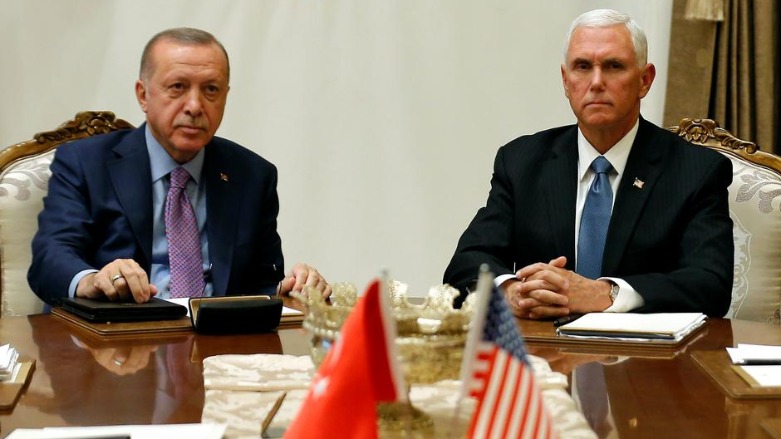US announces northeast Syria ceasefire, but many questions remain

WASHINGTON DC (Kurdistan 24) – After five hours of talks in Ankara on Thursday, a US delegation, led by Vice President Mike Pence, announced that the delegation had secured a ceasefire in northeast Syria between the attacking Turkish forces and the Kurdish-led Syrian Democratic Forces (SDF.)
After more than five hours of negotiations, Pence held a press conference and announced, “Today, the United States and Turkey have agreed to a ceasefire in Syria.”
The ceasefire is to last for five days—120 hours—“in order to allow for the withdrawal of YPG forces from the safe zone,” Pence said.
The Turkish military operation, dubbed by Ankara, “Operation Peace Spring,” is to end entirely “upon the completion of the withdrawal” of the YPG forces.
Pence stated that the US “has already been in contact” with the SDF, and “we have already begun to facilitate their safe withdrawal” from the area of the safe zone—which will stretch some 20 miles into northern Syria, along the Turkish border.
A subsequent statement by the SDF commander, Gen. Mazloum Abdi, confirmed that the SDF had accepted the agreement.
The Kurdish YPG has provided the military leadership of the SDF, which has been America’s principle partner in the fight against the Islamic State in Syria. But Turkey has long regarded the YPG as the Syrian branch of the Kurdistan Workers’ Party (PKK) and a terrorist organization.
Last Wednesday, despite an understanding between the US and Turkey on creating a security mechanism along the Turkish-Syrian border, Turkish forces, along with their Syrian militia, launched a cross-border assault, targeting the SDF.
The Turkish assault drew strong bipartisan criticism in Washington, amid charges that President Donald Trump had not done enough to stop the attack, while it would lead to the reemergence of the Islamic State and redound to the benefit of Russia, Syria, and Iran.
Pence told journalists that Washington had threatened Ankara with “a new round of massive sanctions,” if it did not agree to a ceasefire. With Thursday’s agreement, he explained, no new sanctions will be imposed over the next five days, in which military operations are to be halted, while the SDF withdraws.
Once a permanent ceasefire is established, Pence continued, the US will withdraw the sanctions that it imposed earlier this week on individual Turkish ministers and government agencies.
Despite the agreement, many issues remain. One key question is who will administer the area from which the SDF withdraws? Who will police the area? Who will ensure that the Islamic State does not return?
A basic tenet of US counter-terrorism doctrine is that once an insurgent group is defeated, an administration, acceptable to the local population must be established, otherwise the terrorists will simply return.
Nicholas Heras, a Fellow at the Center for a New American Security, has his doubts. “These are the important details that the Trump team is essentially leaving up to Turkey to dictate,” he told Kurdistan 24.
“For the time being, all this agreement does is create a window for Trump to claim a victory in securing a ‘ceasefire.’” while it “allows Turkey to push for the total displacement of forces it does not like from the border,” he continued.
Moreover, Heras noted that while Pence stated that Turkey would address the problem of the Islamic State prisoners held by the SDF, that could become an issue.
“The future of ISIS and ISIS prisoners has not been a priority” for Ankara, Heras said.
Another unanswered question is the role of Syria and Russia. Troops from those two countries have taken control of Manbij and Kobani, two cities formally controlled by the SDF and US forces.
